Related Research Articles
The Right Opposition or Right Tendency in the All-Union Communist Party (Bolsheviks) was a label formulated by Joseph Stalin in autumn of 1928 for the opposition against certain measures included within the first five-year plan, an opposition which was led by Nikolai Bukharin, Alexei Rykov, Mikhail Tomsky, and their supporters within the Soviet Union that did not follow the so-called "general line of the party". It is also the name given to "right-wing" critics within the Communist movement internationally, particularly those who coalesced in the International Communist Opposition, regardless of whether they identified with Bukharin and Rykov.

A nuclear power phase-out is the discontinuation of usage of nuclear power for energy production. Often initiated because of concerns about nuclear power, phase-outs usually include shutting down nuclear power plants and looking towards fossil fuels and renewable energy. Three nuclear accidents have influenced the discontinuation of nuclear power: the 1979 Three Mile Island partial nuclear meltdown in the United States, the 1986 Chernobyl disaster in the USSR, and the 2011 Fukushima nuclear disaster in Japan.
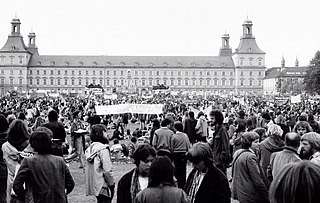
The anti-nuclear movement is a social movement that opposes various nuclear technologies. Some direct action groups, environmental movements, and professional organisations have identified themselves with the movement at the local, national, or international level. Major anti-nuclear groups include Campaign for Nuclear Disarmament, Friends of the Earth, Greenpeace, International Physicians for the Prevention of Nuclear War, Peace Action, Seneca Women's Encampment for a Future of Peace and Justice and the Nuclear Information and Resource Service. The initial objective of the movement was nuclear disarmament, though since the late 1960s opposition has included the use of nuclear power. Many anti-nuclear groups oppose both nuclear power and nuclear weapons. The formation of green parties in the 1970s and 1980s was often a direct result of anti-nuclear politics.
The Abalone Alliance (1977–1985) was a nonviolent civil disobedience group formed to shut down the Pacific Gas and Electric Company's Diablo Canyon Power Plant near San Luis Obispo on the central California coast in the United States. They modeled their affinity group-based organizational structure after the Clamshell Alliance which was then protesting the Seabrook Nuclear Power Plant in coastal New Hampshire. The group of activists took the name "Abalone Alliance" referring to the tens of thousands of wild California Red Abalone that were killed in 1974 in Diablo Cove when the unit's plumbing had its first hot flush.
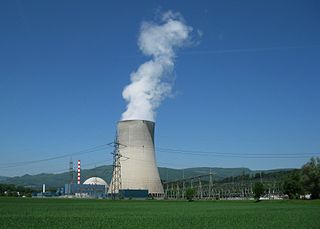
The Gösgen Nuclear Power Plant is located in the Däniken municipality on a loop of the Aar river. It is operated by the ad hoc society Kernkraftwerk Gösgen-Däniken AG.

Nuclear or Not? Does Nuclear Power Have a Place in a Sustainable Energy Future? is a 2007 book edited by Professor David Elliott. The book offers various views and perspectives on nuclear power. Authors include:
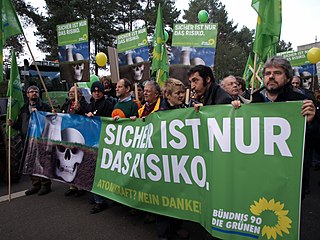
The anti-nuclear movement in Germany has a long history dating back to the early 1970s when large demonstrations prevented the construction of a nuclear plant at Wyhl. The Wyhl protests were an example of a local community challenging the nuclear industry through a strategy of direct action and civil disobedience. Police were accused of using unnecessarily violent means. Anti-nuclear success at Wyhl inspired nuclear opposition throughout West Germany, in other parts of Europe, and in North America. A few years later protests raised against the NATO Double-Track Decision in West Germany and were followed by the foundation of the Green party.
The 1970s proved to be a pivotal period for the anti-nuclear movement in California. Opposition to nuclear power in California coincided with the growth of the country's environmental movement. Opposition to nuclear power increased when President Richard Nixon called for the construction of 1000 nuclear plants by the year 2000.

A peace movement is a social movement which seeks to achieve ideals such as the ending of a particular war or minimizing inter-human violence in a particular place or situation. They are often linked to the goal of achieving world peace. Some of the methods used to achieve these goals include advocacy of pacifism, nonviolent resistance, diplomacy, boycotts, peace camps, ethical consumerism, supporting anti-war political candidates, supporting legislation to remove profits from government contracts to the military–industrial complex, banning guns, creating tools for open government and transparency, direct democracy, supporting whistleblowers who expose war crimes or conspiracies to create wars, demonstrations, and political lobbying. The political cooperative is an example of an organization which seeks to merge all peace-movement and green organizations; they may have diverse goals, but have the common ideal of peace and humane sustainability. A concern of some peace activists is the challenge of attaining peace when those against peace often use violence as their means of communication and empowerment.
Licensed to Kill? The Nuclear Regulatory Commission and the Shoreham Power Plant, a 1998 book by Joan Aron, presents the first detailed case study of how an activist public and elected officials of New York state opposed the Shoreham Nuclear Power Plant on Long Island. The book explains that nuclear power faltered when "public concerns about health, safety, and the environment superseded other interests about national security or energy supplies".

Critical Masses: Opposition to Nuclear Power in California, 1958–1978 is the first detailed history of the anti-nuclear movement in the United States, written by Thomas Wellock. It is also the first state-level research on the subject with a focus on California. Reviewer Paula Garb has said:
The book is rich with vivid verbal pictures and the passionate voices of participants on all sides of the controversy around the peaceful atom. It is based on interviews, documents from state and federal archives, and activist papers. Wellock brings to this project the expertise of a former engineer for civilian and navy nuclear reactors, a thorough archivist, and a sensitive interviewer.

Nuclear Politics in America is a 1997 book by Robert J. Duffy. According to Duffy, the "promise and peril of nuclear power have been a preoccupation of the modern age", who was then an assistant professor of political science at Rider University.

Anti-nuclear protests began on a small scale in the U.S. as early as 1946 in response to Operation Crossroads. Large scale anti-nuclear protests first emerged in the mid-1950s in Japan in the wake of the March 1954 Lucky Dragon Incident. August 1955 saw the first meeting of the World Conference against Atomic and Hydrogen Bombs, which had around 3,000 participants from Japan and other nations. Protests began in Britain in the late 1950s and early 1960s. In the United Kingdom, the first Aldermaston March, organised by the Campaign for Nuclear Disarmament, took place in 1958. In 1961, at the height of the Cold War, about 50,000 women brought together by Women Strike for Peace marched in 60 cities in the United States to demonstrate against nuclear weapons. In 1964, Peace Marches in several Australian capital cities featured "Ban the Bomb" placards.
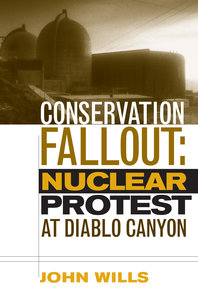
Conservation Fallout: Nuclear Protest at Diablo Canyon is a 2006 book by John Wills.
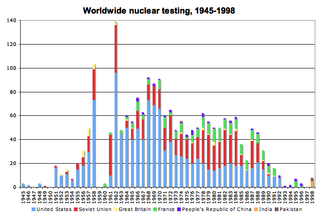
The application of nuclear technology, both as a source of energy and as an instrument of war, has been controversial.

The international reaction to the 2011 Fukushima Daiichi nuclear disaster has been diverse and widespread. Many inter-governmental agencies responded to the Japanese Fukushima Daiichi nuclear disaster, often on an ad hoc basis. Responders included International Atomic Energy Agency, World Meteorological Organization and the Preparatory Commission for the Comprehensive Nuclear Test Ban Treaty Organization, which has radiation detection equipment deployed around the world.
The 1999 Blayais Nuclear Power Plant flood was a flood that took place on the evening of December 27, 1999. It was caused when a combination of the tide and high winds from the extratropical storm Martin led to overwhelming of the seawalls of the Blayais Nuclear Power Plant in France. The event resulted in the loss of the plant's off-site power supply and knocked out several safety-related systems, resulting in a Level 2 event on the International Nuclear Event Scale. The incident illustrated the potential for flooding to damage multiple items of equipment throughout a plant, weaknesses in safety measures, systems and procedures, and resulted in fundamental changes to the evaluation of flood risk at nuclear power plants and in the precautions taken. It was in some sense a forerunner of the 2011 Fukushima I nuclear accidents in Japan, but did not trigger the worldwide protection work on low-lying plants that the latter would.

Contesting the Future of Nuclear Power: A Critical Global Assessment of Atomic Energy is a 2011 book by Benjamin K. Sovacool, published by World Scientific. Sovacool's book addresses the current status of the global nuclear power industry, its fuel cycle, nuclear accidents, environmental impacts, social risks, energy payback, nuclear power economics, and industry subsidies. There is a postscript on the Japanese 2011 Fukushima nuclear disaster. Based on detailed analysis, Sovacool concludes "that a global nuclear renaissance would bring immense technical, economic, environmental, political, and social costs". He says that it is renewable energy technologies which will enhance energy security, and which have many other advantages.

The Doomsday Machine: The High Price of Nuclear Energy, the World's Most Dangerous Fuel is a 2012 book by Martin Cohen and Andrew McKillop which addresses a broad range of concerns regarding the nuclear industry, the economics and environmental aspects of nuclear energy, nuclear power plants, and nuclear accidents. The book has been described by The New York Times as "a polemic on the evils of splitting the atom".
References
- ↑ Reviewed by Andrew J. Pierre, Foreign Affairs, Fall 1981 Archived 2004-09-17 at the Wayback Machine
- ↑ Book review